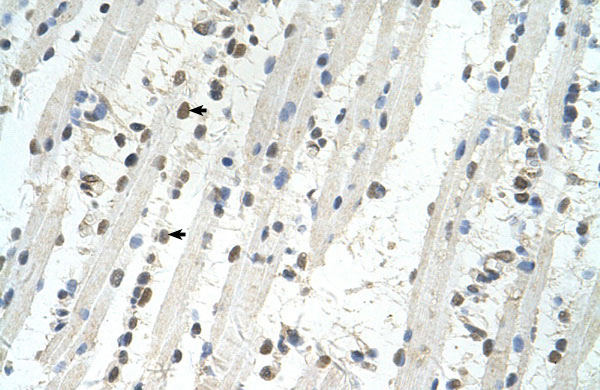TRIM32 antibody - C-terminal region
Rabbit Polyclonal Antibody
- 产品详情
- 实验流程
Application
| WB, IHC |
|---|---|
| Primary Accession | Q13049 |
| Other Accession | NM_012210, NP_036342 |
| Reactivity | Human, Mouse, Rat, Rabbit, Zebrafish, Pig, Dog, Horse, Bovine |
| Predicted | Mouse, Rat, Rabbit, Zebrafish, Pig, Chicken, Bovine |
| Host | Rabbit |
| Clonality | Polyclonal |
| Calculated MW | 71989 Da |
| Gene ID | 22954 |
|---|---|
| Alias Symbol | BBS11, HT2A, LGMD2H, TATIP |
| Other Names | E3 ubiquitin-protein ligase TRIM32, 6.3.2.-, 72 kDa Tat-interacting protein, Tripartite motif-containing protein 32, Zinc finger protein HT2A, TRIM32, HT2A |
| Format | Liquid. Purified antibody supplied in 1x PBS buffer with 0.09% (w/v) sodium azide and 2% sucrose. |
| Reconstitution & Storage | Add 100 ul of distilled water. Final anti-TRIM32 antibody concentration is 1 mg/ml in PBS buffer with 2% sucrose. For longer periods of storage, store at 20°C. Avoid repeat freeze-thaw cycles. |
| Precautions | TRIM32 antibody - C-terminal region is for research use only and not for use in diagnostic or therapeutic procedures. |
| Name | TRIM32 (HGNC:16380) |
|---|---|
| Synonyms | HT2A |
| Function | E3 ubiquitin ligase that plays a role in various biological processes including neural stem cell differentiation, innate immunity, inflammatory resonse and autophagy (PubMed:19349376, PubMed:31123703). Plays a role in virus-triggered induction of IFN-beta and TNF-alpha by mediating the ubiquitination of STING1. Mechanistically, targets STING1 for 'Lys-63'-linked ubiquitination which promotes the interaction of STING1 with TBK1 (PubMed:22745133). Regulates bacterial clearance and promotes autophagy in Mycobacterium tuberculosis-infected macrophages (PubMed:37543647). Negatively regulates TLR3/4-mediated innate immune and inflammatory response by triggering the autophagic degradation of TICAM1 in an E3 activity-independent manner (PubMed:28898289). Plays an essential role in oxidative stress induced cell death by inducing loss of transmembrane potential and enhancing mitochondrial reactive oxygen species (ROS) production during oxidative stress conditions (PubMed:32918979). Ubiquitinates XIAP and targets it for proteasomal degradation (PubMed:21628460). Ubiquitinates DTNBP1 (dysbindin) and promotes its degradation (PubMed:19349376). May ubiquitinate BBS2 (PubMed:22500027). Ubiquitinates PIAS4/PIASY and promotes its degradation in keratinocytes treated with UVB and TNF-alpha (By similarity). Also acts as a regulator of autophagy by mediating formation of unanchored 'Lys-63'-linked polyubiquitin chains that activate ULK1: interaction with AMBRA1 is required for ULK1 activation (PubMed:31123703). Positively regulates dendritic branching by promoting ubiquitination and subsequent degradation of the epigenetic factor CDYL (PubMed:34888944). Under metabolic stress and phosphorylation by CHK2, mediates 'Lys-63'-linked ubiquitination of ATG7 at 'Lys-45' to initiate autophagy (PubMed:37943659). |
| Cellular Location | Cytoplasm. Mitochondrion. Endoplasmic reticulum. Note=Localized in cytoplasmic bodies, often located around the nucleus |
| Tissue Location | Spleen, thymus, prostate, testis, ovary, intestine, colon and skeletal muscle. |
Research Areas
For Research Use Only. Not For Use In Diagnostic Procedures.
Application Protocols
Provided below are standard protocols that you may find useful for product applications.
REFERENCES
Chiang,A.P., (2006) Proc. Natl. Acad. Sci. U.S.A. 103 (16), 6287-6292Reconstitution and Storage:For short term use, store at 2-8C up to 1 week. For long term storage, store at -20C in small aliquots to prevent freeze-thaw cycles.
终于等到您。ABCEPTA(百远生物)抗体产品。
点击下方“我要评价 ”按钮提交您的反馈信息,您的反馈和评价是我们最宝贵的财富之一,
我们将在1-3个工作日内处理您的反馈信息。
如有疑问,联系:0512-88856768 tech-china@abcepta.com.























 癌症的基本特征包括细胞增殖、血管生成、迁移、凋亡逃避机制和细胞永生等。找到癌症发生过程中这些通路的关键标记物和对应的抗体用于检测至关重要。
癌症的基本特征包括细胞增殖、血管生成、迁移、凋亡逃避机制和细胞永生等。找到癌症发生过程中这些通路的关键标记物和对应的抗体用于检测至关重要。 为您推荐一个泛素化位点预测神器——泛素化分析工具,可以为您的蛋白的泛素化位点作出预测和评分。
为您推荐一个泛素化位点预测神器——泛素化分析工具,可以为您的蛋白的泛素化位点作出预测和评分。 细胞自噬受体图形绘图工具为你的蛋白的细胞受体结合位点作出预测和评分,识别结合到自噬通路中的蛋白是非常重要的,便于让我们理解自噬在正常生理、病理过程中的作用,如发育、细胞分化、神经退化性疾病、压力条件下、感染和癌症。
细胞自噬受体图形绘图工具为你的蛋白的细胞受体结合位点作出预测和评分,识别结合到自噬通路中的蛋白是非常重要的,便于让我们理解自噬在正常生理、病理过程中的作用,如发育、细胞分化、神经退化性疾病、压力条件下、感染和癌症。







